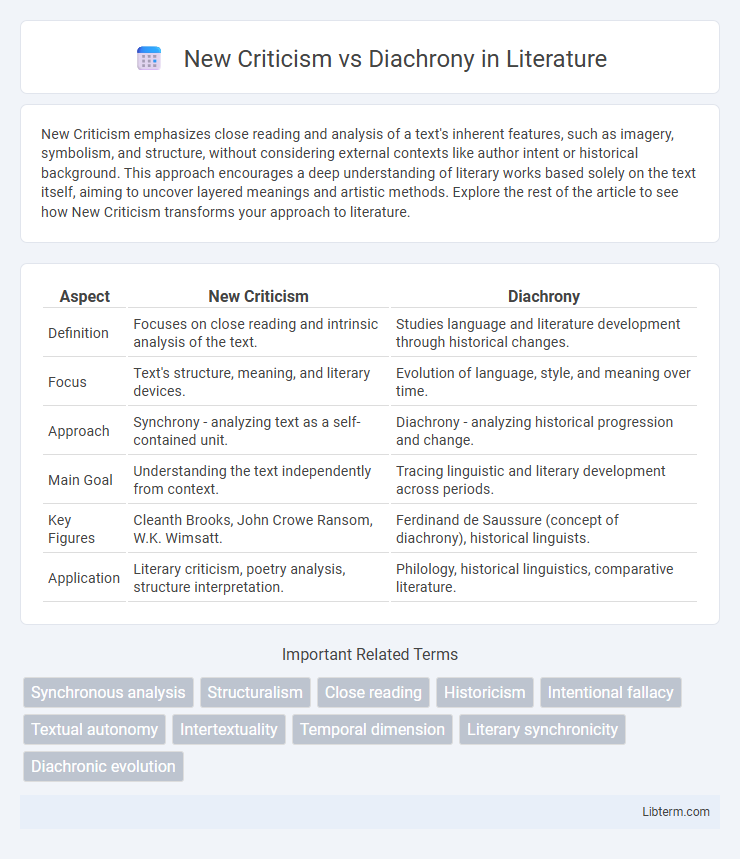New Criticism emphasizes close reading and analysis of a text's inherent features, such as imagery, symbolism, and structure, without considering external contexts like author intent or historical background. This approach encourages a deep understanding of literary works based solely on the text itself, aiming to uncover layered meanings and artistic methods. Explore the rest of the article to see how New Criticism transforms your approach to literature.
Table of Comparison
| Aspect | New Criticism | Diachrony |
|---|---|---|
| Definition | Focuses on close reading and intrinsic analysis of the text. | Studies language and literature development through historical changes. |
| Focus | Text's structure, meaning, and literary devices. | Evolution of language, style, and meaning over time. |
| Approach | Synchrony - analyzing text as a self-contained unit. | Diachrony - analyzing historical progression and change. |
| Main Goal | Understanding the text independently from context. | Tracing linguistic and literary development across periods. |
| Key Figures | Cleanth Brooks, John Crowe Ransom, W.K. Wimsatt. | Ferdinand de Saussure (concept of diachrony), historical linguists. |
| Application | Literary criticism, poetry analysis, structure interpretation. | Philology, historical linguistics, comparative literature. |
Defining New Criticism: Core Principles
New Criticism emphasizes close reading and analysis of the text itself, focusing on its structure, imagery, and meaning without considering historical context or authorial intent. It prioritizes the text's intrinsic value, treating it as an autonomous object where form and content are inseparable. The core principles include unity, paradox, ambiguity, and the text's organic wholeness to uncover timeless literary truths.
Understanding Diachrony in Literary Studies
Diachrony in literary studies examines texts through historical development, tracking linguistic, thematic, and cultural changes over time to understand the evolution of meaning. Unlike New Criticism, which isolates a text for close reading with emphasis on internal structure and inherent meaning, diachronic analysis contextualizes literature within broader historical and temporal frameworks. This method reveals shifts in literary conventions and societal influences, offering dynamic insights into how meanings transform across periods.
Historical Origins: New Criticism and Diachrony
New Criticism emerged in the early 20th century, emphasizing close reading and the intrinsic value of the text independent of historical context. In contrast, Diachrony centers on the historical development and evolution of language, literature, and cultural phenomena over time. The historical origins of New Criticism lie in reaction to biographical and historical criticism, while Diachrony roots in linguistics, particularly the work of Ferdinand de Saussure and historical linguistics.
Key Proponents and Theorists
New Criticism, championed by key figures such as Cleanth Brooks, John Crowe Ransom, and T.S. Eliot, emphasizes close reading and the intrinsic features of the text, advocating for a synchronic approach that focuses on literary structure and meaning without historical context. In contrast, diachrony involves examining the historical evolution and development of language or literature over time, with influential theorists like Ferdinand de Saussure and Roman Jakobson who emphasize linguistic change and the dynamic processes shaping texts. These differing approaches highlight the tension between analyzing literature as an isolated artifact versus understanding it within its historical and cultural transformations.
Textual Analysis: Close Reading vs. Historical Context
New Criticism emphasizes close reading, analyzing the text's formal elements such as imagery, symbolism, and structure without considering historical context. Diachrony focuses on the evolution of language and meaning over time, integrating historical context to understand textual changes and interpretations. Close reading isolates the text itself, while diachronic analysis situates the text within its cultural and temporal development.
The Role of Authorial Intent
New Criticism emphasizes the text itself, minimizing authorial intent by treating the work as an autonomous entity whose meaning derives from its structure and language. Diachrony, concerned with historical development, incorporates authorial intent to understand how meanings evolve over time within their socio-cultural contexts. The role of authorial intent is thus central to diachronic analysis but largely disregarded in New Criticism's synchronic reading.
Strengths and Limitations of New Criticism
New Criticism emphasizes close reading and textual analysis, focusing on the poem or literary work as an independent entity, which strengthens interpretation by minimizing external biases and authorial intent. Its limitation lies in neglecting historical context and the evolution of language, which can obscure deeper meanings related to cultural and temporal influences. This approach excels in uncovering structural and linguistic nuances but often underrepresents the dynamic, diachronic development of texts across time.
The Significance of Diachronic Approaches
Diachronic approaches prioritize historical context and linguistic evolution, offering insights into how texts acquire meaning across time, which contrasts with New Criticism's focus on the text as an autonomous, timeless artifact. By analyzing how language and cultural references transform, diachronic methods uncover layers of meaning and intertextuality that static New Critical readings might overlook. This historical perspective enriches literary interpretation by situating works within dynamic processes of change, illuminating shifts in authorial intent and reader reception.
Comparative Case Studies: Practical Applications
New Criticism emphasizes close reading and textual analysis within the fixed context of a literary work, focusing on its intrinsic features such as imagery, structure, and symbolism. Diachrony examines texts over time, tracing linguistic, thematic, or cultural changes to reveal historical evolution and intertextual relationships. Comparative case studies highlight that New Criticism excels in detailed, micro-level interpretation of individual texts, while Diachrony offers macro-level insights into literary development, enriching understanding through temporal and contextual dimensions.
Impact and Relevance in Modern Literary Theory
New Criticism revolutionized literary analysis by emphasizing close reading and intrinsic textual features, significantly shaping mid-20th century literary theory. Diachrony, focused on historical and temporal development of texts, contrasts by prioritizing the evolution of language and meaning over time, influencing modern contextual and comparative approaches. The enduring impact of New Criticism lies in its methodological rigor and precision, while Diachronic analysis remains relevant for understanding literature's dynamic cultural and linguistic transformations.
New Criticism Infographic

 libterm.com
libterm.com